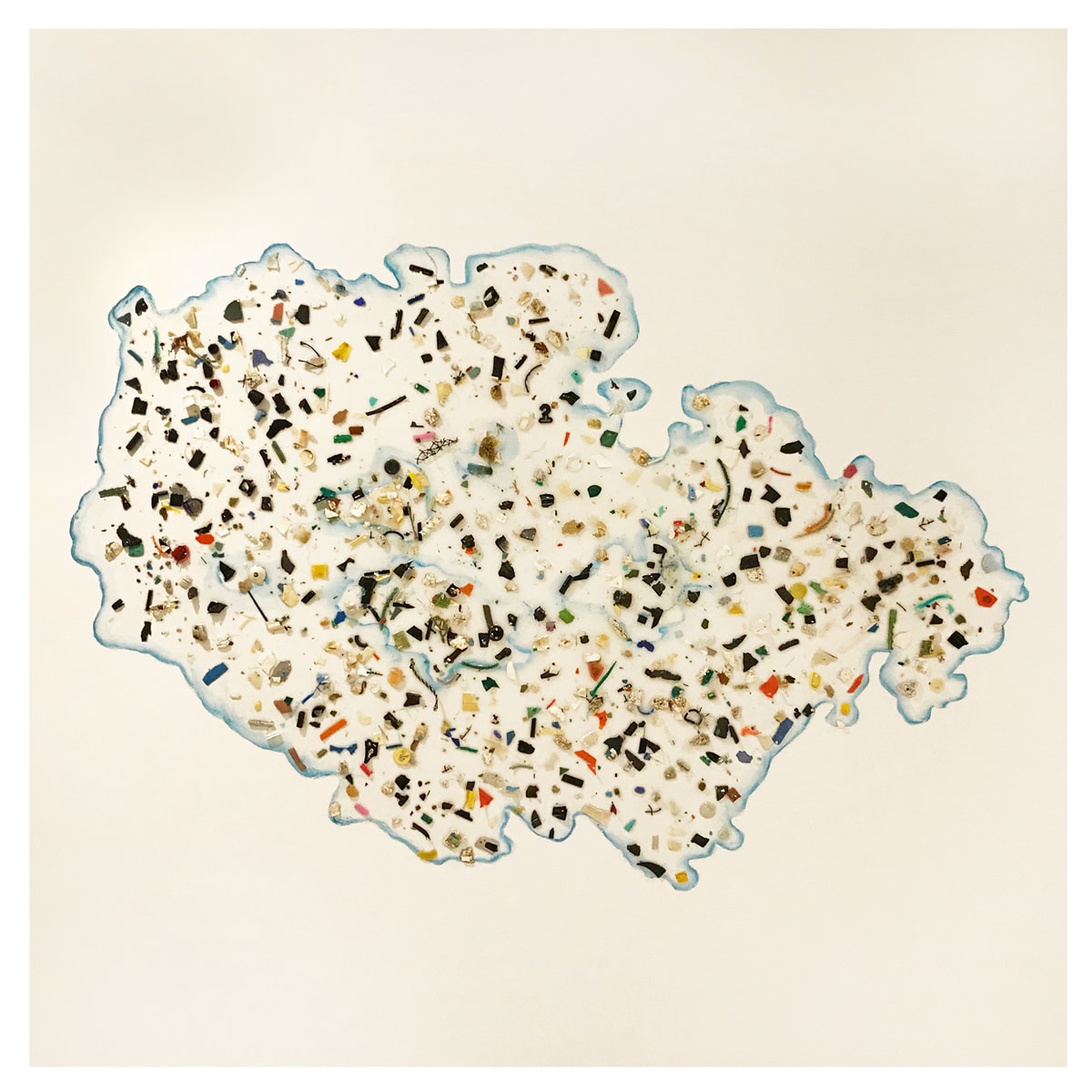
Figure 6: John Dahlsen, GYRE 1, 2020
Micro plastics, plant-based resin, ink and charcoal on Belgian linen
183 x 183cm
Courtesy of the artist

Found plastics, resin (sustainable plant based), chalk, primed Belgian linen
183 x 183cm
Courtesy of the artist
THE PLASTIC TURN
Ranjan Ghosh
The book The Plastic Turn is forthcoming with Cornell University Press.
78 DIACRITICS >> 2021 >> 49.1
The Plastic Turn (Ithaca, London: Cornell University Press, forthcoming, 2022)
The material-aesthetic paradigm brings us to Australian artist John Dahlsen’s “Gyre” series, which manifests a plasticity of space that represents more and more plastic waste gyring into the existing waste, enlarging and intensifying it. Dahlsen’s garbage patch images show the miscellany and divergence of material incorporation. “Gyre 1” (Figure 6) makes visible an ever-increasing complicated pattern and formation as materials flow in from disparate directions to generate an entangled circulation of material mass: density, concentration, mobility, and scalarity.
The patch looks like a totality, but it is not immobile nor congealing around a particular point of emergence. The buoyant plastics in unimaginable heterogeneity travel from across Asia and North America, riding the sea currents to silently dilate the seemingly fixed body of material mass. The gyre’s foundation is shaped by irresistible mobilities, wind and sea currents, an undergirding swirling force. The mobile and ever enlarging totality of the gyre, its changing densities, flow patterns, variations in material influx, degradation and fragmentation, allow us to rethink the “plastic literary” from a different vantage point, not in the sense of modernist or anthropophagic intertextuality, but global literary circulation. Can Waiting for Godot, Ulysses, Midnight’s Children and other literary classics be instances of world-widening gyres?
We expend and something grows at our expense: a fluidity on the other side of consciousness, a developmental rhythm effected through our relentless investments and unabated expenditure on our desires and habitabilities. Bioplastics stay suspended under various stages of degradation; concepts and ideational linkages are suspended particles in the plastic “literary” gyre which often get spat out into certain accumulative forms with a variety of effects and modes of consumption. The gyre self-exceeds and keeps on refiguring itself as much as the plastic literary that initiates different formations beyond its established core of existence. The gyre plasticizes; islands of plastic-thoughts form and extend; the conceptual soup announces identity but not without an inherent connective and accumulative strength and energy. The “folded waters”35 are folded identities: we own plastic in a continuum, indefensibly transmissive and transformative, as much as we live in a literary-totality. This totality is plastic-restive and plastic-transitive in a kind of inexhaustible plenitude. We expend our lives on plastic; we expend our critical-literary thinking on the literary-totality. On both sides of the performance—plastic and plastic thinking—we expend to regenerate. Startling figures and connections throw up on plastics as they are washed ashore or collected from unsuspected zones of accumulation. The plastic in the literary-totality seeks comradeship among seemingly incommensurable coordinates of interaction and creates a world where all literary thinking is “folded.” This announces the excitement of assemblage through disjunctures and differences among literatures across cultures and nations. The unfathomable widening gyre, thus, analogizes the plastic-worlding in world literature with its uncanny verticality and indeterminacy of scalar sweep. The literary gyre destabilizes itself in a continuity that corresponds with the deconstruction of the canonizing principles of world literature, making for scalar and volumetric changes in understanding nation, borders, imperialistic politics of literary framing, and manipulative ideological drift and discourse.
